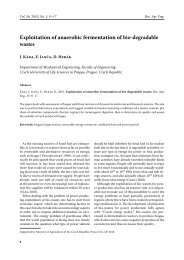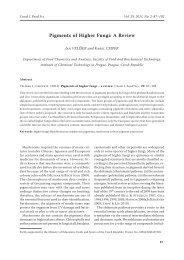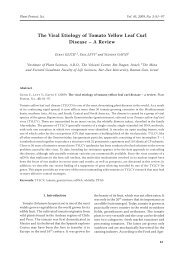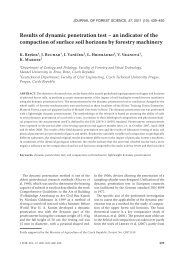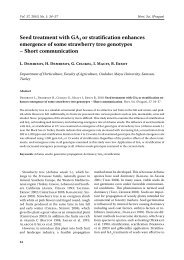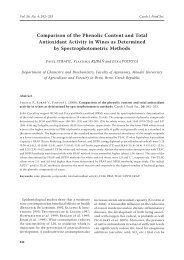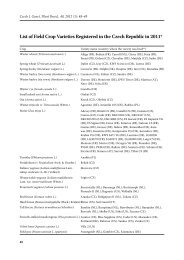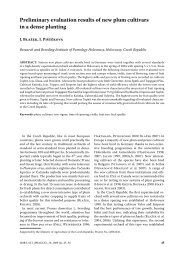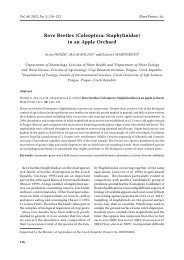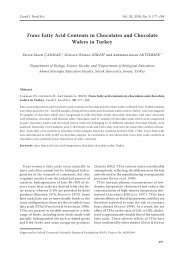Formulation, Physicochemical, Nutritional and Sensorial Evaluation ...
Formulation, Physicochemical, Nutritional and Sensorial Evaluation ...
Formulation, Physicochemical, Nutritional and Sensorial Evaluation ...
You also want an ePaper? Increase the reach of your titles
YUMPU automatically turns print PDFs into web optimized ePapers that Google loves.
Vol. 30, 2012, No. 2: 118–125 Czech J. Food Sci.<br />
118<br />
<strong>Formulation</strong>, <strong>Physicochemical</strong>, <strong>Nutritional</strong> <strong>and</strong> <strong>Sensorial</strong><br />
<strong>Evaluation</strong> of Corn Tortillas Supplemented with Chía Seed<br />
(Salvia hispanica L.)<br />
Rodolfo Rendón-VillaloboS 1 , am<strong>and</strong>a oRtíz-Sánchez 2 ,<br />
Javier SoloRza-FeRia 1 <strong>and</strong> cesar arnulfo tRuJillo-heRnández 1<br />
1 centro de desarrollo de Productos bióticos, instituto Politécnico nacional, Yautepec, México;<br />
2 centro de investigación en biodiversidad y conservación, universidad autónoma del estado<br />
Abstract<br />
de Morelos, cuernavaca, México<br />
Rendón-Villalobos R., Ortíz-Sánchez A., Solorza-Feria J., Trujillo-Hernández C.A. (2012):<br />
<strong>Formulation</strong>, physicochemical, nutritional <strong>and</strong> sensorial evaluation of corn tortillas supplemented<br />
with chía seed (Salvia hispanica L.). Czech J. Food Sci., 30: 118–125.<br />
Composite flours containing 5%, 10%, 15%, <strong>and</strong> 20% of chia seed flour <strong>and</strong> corn were used for tortilla formulations.<br />
The effects of chia powders supplementation on the physicochemical <strong>and</strong> sensorial characteristics as well as starch<br />
digestibility of the tortillas were evaluated. <strong>Nutritional</strong>ly, all chia tortillas had significantly higher levels (P < 0.001) of<br />
protein, lipids, <strong>and</strong> total dietary fibre than the control. The reduced enzymatic starch hydrolysis rate <strong>and</strong> predicted<br />
glycemic index recorded for the chia seed-added tortilla indicated slow digestion features. Sensory evaluation did not<br />
show significant (P > 0.05) differences in the attributes among tortillas. Owing to the increase in the total dietary fibre,<br />
lower digestion, <strong>and</strong> predicted glycemic index values, chia seed-added tortilla can be considered as a nutraceutical<br />
food. Therefore, the newly developed tortilla supplemented with chia seed flour could represent a valuable staple in<br />
improving the nutritional value of the original food product.<br />
Keywords: nutraceutical; glycemic index; Fibre-rich<br />
Changes in human diets over the past years, particularly<br />
in terms of the dietary fat intake <strong>and</strong> its<br />
effect on human health, have become a major interest<br />
in the nutrition research (Risérus et al. 2009).<br />
Epidemiological <strong>and</strong> scientific evidence has shown a<br />
strong relationship betweem the total fat intake <strong>and</strong><br />
its composition <strong>and</strong> a number of diseases, including<br />
coronary heart disease, cancer, diabetes, <strong>and</strong> depression<br />
(Kris-Etherton et al. 2002). There is growing<br />
consensus that dietary habits adopted by Western<br />
societies over the past 100 year have contributed<br />
to the increased risk of not only coronary heart<br />
disease, but also hypertension, diabetes, <strong>and</strong> cancer<br />
(Okuyama et al. 1997; Henning & Watkins 1998).<br />
During the last century, the emergence of processed<br />
foods, grain-fattened livestock, <strong>and</strong> hydrogenated<br />
vegetable fats has reduced the intake of ω-3 fatty<br />
acids while increasing the intake of ω-6 fatty acids<br />
<strong>and</strong> saturated fats (Simopoulos 1999), because many<br />
of these oils are used in the production of many of<br />
Supported by Secretaría de Investigación y Posgrado del Instituto Politécnico Nacional (SIP-IPN), Comisión de Operación<br />
y Fomento a las Actividades Académicas del Instituto Politécnico Nacional (COFAA-IPN), <strong>and</strong> Estimulos al<br />
Desempeño de los Investigadores del Instituto Politécnico Nacional (EDI-IPN).
Czech J. Food Sci. Vol. 30, 2012, No. 2: 118–125<br />
the processed foods. They are also found extensively<br />
in a wide range of foods consumed every day.<br />
However, the nutritional community’s attention<br />
has recently been drawn to a novel whole grain,<br />
chia seed, whose oil content ranges from 25% to<br />
35% with high concentrations of polyunsaturated<br />
fatty acids as well as a complement of vitamins <strong>and</strong><br />
minerals (Chicco et al. 2009; Coates & Ayerza<br />
2009). Whole grains are important sources of many<br />
nutrients such as dietary fibre, resistant starch, trace<br />
minerals, vitamins, folic acid, selenium, zinc, phenolic<br />
compounds, <strong>and</strong> other compounds including<br />
phytoestrogens <strong>and</strong> antioxidants, which may contribute<br />
to the apparent cardioprotective effects of<br />
whole grains (Djoussé et al. 2007). Not only that,<br />
it is touted as having the highest fiber content out<br />
of any food, being beneficial for type 2 diabetics<br />
(Vuksan et al. 2007), reduction of cholesterolaemia,<br />
modification of the glycemic <strong>and</strong> insulinaemic<br />
responses, changes in intestinal function <strong>and</strong> antioxidant<br />
activity (Borderías et al. 2005; Esposito<br />
et al. 2005). Previous research has shown that sugars<br />
are progressively liberated from tortilla mixed with<br />
whole seed during digestion, leading to a st<strong>and</strong>ard<br />
increase in postpr<strong>and</strong>ial blood glucose <strong>and</strong> insulin<br />
response (glycemic index; Islas-Hernández et<br />
al. 2007; Rendón-Villalobos et al. 2009). Lowglycemic<br />
index foods have been shown to positively<br />
affect lifestyle through various mechanisms, including<br />
the improvement of glucose tolerance (Liljeberg et<br />
al. 1999) <strong>and</strong> helping maintaining a better cognitive<br />
performance throughout the day (Papanikolaou<br />
et al. 2006), <strong>and</strong> can also be used in the treatment<br />
of obesity, type 2 diabetes mellitus, <strong>and</strong> in weight<br />
management (Anton et al. 2008; Rendón-Villalobos<br />
et al. 2009). Chia seeds from Salvia hispanica<br />
L., Salvia colurnbria Benth, Salvia polystachya, <strong>and</strong><br />
other Salvia members of the family Labiatae have long<br />
been used as a food ingredient, oil source, medicine,<br />
<strong>and</strong> are especially well known by American Indians<br />
<strong>and</strong> rural Mexicans (Cahill 2003; Reyes-Caudillo<br />
et al. 2008). Economic historians have suggested<br />
that S. hispanica as staple food was as important<br />
as maize <strong>and</strong> in some areas even more important<br />
(Cahill 2003).<br />
Therefore, the purpose of this study was to develop<br />
nutritionally enhanced tortillas by incorporating<br />
an ingredient with well-documented nutritional<br />
functionality (chia seed) in a corn tortilla, in an<br />
attempt to create a low-glycemic index (GI) <strong>and</strong><br />
fibre-rich product while preserving the sensory<br />
acceptability <strong>and</strong> physicochemical properties.<br />
MATERIAL AND METHODS<br />
General. Corn tortillas were produced in the<br />
Quality Control Laboratory, CEPROBI-IPN. Nixtamalised<br />
corn flour (NCF) (MASECA TM , León,<br />
Mexico) <strong>and</strong> whole chia seed (Agrobeck International<br />
de México TM , SPR de RL de CV, Guada-<br />
lajara, Jalisco, México) were obtained from a selected<br />
supermarket. Whole seeds were ground in<br />
a Tekmar TM analytical mill (Model A-10; Tekmar<br />
Co., Cincinnati, USA).<br />
Tortilla preparation. Corn tortillas were produced<br />
using the method described by Rendón-<br />
Villalobos et al. (2009). NCF (100 g) (either<br />
NCF or composites) with weight adjusted to 14%<br />
of moisture content added at different levels (5%,<br />
10%, 15%, <strong>and</strong> 20% of chia seed powder). The dry<br />
ingredients plus shortening were mixed for 2 min<br />
before water addition. Once water was added,<br />
the batter was further mixed to form masa, <strong>and</strong><br />
cut into pieces of 35 grams. These pieces were<br />
rounded <strong>and</strong> pressure-molded <strong>and</strong> extruded into<br />
thin circles to make tortillas 1 mm thick. Thereafter,<br />
the tortillas were transferred onto a hot<br />
plate preheated at 250°C <strong>and</strong> baked for 30 s on<br />
the first side, flipped, <strong>and</strong> baked for 40 s on the<br />
second side, <strong>and</strong> flipped <strong>and</strong> baked for another<br />
10 s on the first side. The baked tortillas were<br />
cooled on a rack for 1 min <strong>and</strong> then frozen at<br />
–50°C, 5 Pa, for 48 h in a freeze dryer (VirTis<br />
Consol 25SL; VirTis, Gardiner, USA).<br />
Proximate analyses. The freeze-dried tortillas<br />
were analysed for their moisture content by AOAC<br />
method 925.10 (AOAC 2000). Due to the different<br />
moisture contents of the samples, all calculations<br />
were made on a dry matter basis. Ash <strong>and</strong> fat<br />
were analysed according to the approved methods<br />
08-01 <strong>and</strong> 30-25, respectively (AACC 2000).<br />
Nitrogen content was determined by the Kjeldahl<br />
method 46-13 <strong>and</strong> was multiplied by a factor of<br />
5.85 to estimate protein content (AACC 2000).<br />
Total dietary fibre (TDF) was evaluated using the<br />
AOAC method 985.29 (AOAC 2000). All analyses<br />
were performed in triplicate. The samples were<br />
gelatinised with a heat-stable α-amylase (pH 6,<br />
100°C, 30 min) <strong>and</strong> digested enzymatically first<br />
with protease (pH 7.5, 60°C, 30 min) <strong>and</strong> then<br />
with amyloglucosidase (pH 6, 60°C, 30 min) to<br />
remove protein <strong>and</strong> starch. TDF was precipitated<br />
with ethanol, <strong>and</strong> after washing <strong>and</strong> drying, the<br />
residue was weighed. The results were corrected<br />
for protein <strong>and</strong> ash contents.<br />
119
Vol. 30, 2012, No. 2: 118–125 Czech J. Food Sci.<br />
In vitro digestibility tests. Total starch content<br />
was determined by the method of Goñi et al.<br />
(1997). In brief, a 50 mg sample was dispersed in<br />
2M KOH to hydrolyse all the starch (30 min) <strong>and</strong><br />
subsequently incubated (60°C, 45 min, pH 4.75)<br />
with amyloglucosidase; glucose content was then<br />
determined using the glucose oxidase/peroxidase<br />
assay (SERA-PAK TM Plus; Bayer de México, S.A.<br />
de C.V., Ciudad de México, Mexico). Total starch<br />
content was calculated as glucose (mg) × 0.9; potato<br />
starch was used as a reference. Potentially<br />
available starch content was assessed following<br />
the multienzymatic protocol of Holm et al. (1986)<br />
using heat-stable α-amylase <strong>and</strong> amyloglucosidase.<br />
In brief, the sample (300 mg, dry basis) was suspended<br />
in 20 ml of distilled water <strong>and</strong> incubated<br />
with heat-stable α-amylase in a boiling water bath<br />
for 20 minutes. This mixture was then diluted<br />
to 100 ml with distilled water. To 0.5 ml of this<br />
suspension, amyloglucosidase <strong>and</strong> 0.1M sodium<br />
acetate buffer (pH 4.75, 1.0 ml) were added. The<br />
mixture was incubated at 60°C for 30 min, diluted<br />
to 10 ml with distilled water <strong>and</strong> analysed for glucose<br />
using the glucose oxidase/peroxidase assay.<br />
The in vitro rate of hydrolysis was measured using<br />
hog pancreatic α-amylase according to Holm et al.<br />
(1985). Each assay was run with 500 mg of available<br />
starch. Predicted Glycemic Index (pGI) was<br />
calculated from the α-amylolysis curves, using the<br />
empiric formula GI = 39.21 + 0.803 h 90 (r = 0.91,<br />
P < 0.05) established by Goñi et al. (1997).<br />
Sensory evaluation. Fresh tortillas were evaluated<br />
in a sensory evaluation laboratory under white<br />
light for colour, flavour, taste, aroma intensity, <strong>and</strong><br />
general acceptability on a 3 point hedonic scale<br />
in which score 1 represented the attributes most<br />
120<br />
disliked <strong>and</strong> score 3 the attributes most liked. A<br />
panel of seventeen judges (untrained but familiar<br />
with corn tortillas) consisting of r<strong>and</strong>omly selected<br />
students <strong>and</strong> staff members was used. Coded samples<br />
were presented on white plates. The judges<br />
were asked to rinse their mouths with tap water<br />
between the samples.<br />
Statistical analysis. All determinations were<br />
carried out at least in triplicate <strong>and</strong> the values were<br />
averaged <strong>and</strong> given as the means with the st<strong>and</strong>ard<br />
errors of the means (± SEM). One-way analysis of<br />
variance (ANOVA) was used to analyse the data.<br />
Tukey’s multiple range test at a significance level of<br />
P ≤ 0.05 was used to identify significant differences<br />
in the means of the parameters measured. Statgraphic<br />
Plus TM version 5.1 <strong>and</strong> Microsoft Excel TM<br />
2007 were used for all statistical analyses.<br />
RESULTS AND DISCUSION<br />
Proximate analyses<br />
The moisture value in the chia seed-added tortilla<br />
decreased by 43.17–41.83% at all levels of substitution;<br />
however, there were no significant differences<br />
(P > 0.05) in relation to moisture content in tortillas<br />
made with different percentages of chia seed<br />
powder (Table 1). This pattern might be related<br />
to the hydrophobic character imparted by the oil<br />
present in chia seed. Rendón-Villalobos et al.<br />
(2009) showed that the reduction in the moisture<br />
content in tortilla resulted from increased levels of<br />
substitution of flax seed flour with corn. According<br />
to Agama-Acevedo et al. (2004, 2005) the<br />
moisture content in tortillas ranges between 35%<br />
Table 1. Average chemical composition (%) of tortilla containing different ground chia seed levels<br />
Sample Moisture Fat1 Protein1,2 Ash1 TDF<br />
Control 47.12 ± 0.12a 4.08 ± 0.11a 9.01 ± 0.22a 1.29 ± 0.11a 16.45 ± 0.23a A 43.17 ± 0.28b 6.25 ± 0.05b 9.41 ± 0.30a 1.34 ± 0.02a 17.66 ± 0.33b B 43.33 ± 0.20 b 7.90 ± 0.01 c 9.98 ± 0.01 a 1.52 ± 0.02 a 21.28 ± 0.45 c<br />
C 42.50 ± 0.29b,c 9.45 ± 0.15d 11.15 ± 0.59b 1.64 ± 0.01a 23.24 ± 0.32d D 41.83 ± 0.13c 10.95 ± 0.15e 12.48 ± 0.02c 1.76 ± 0.05a 25.71 ± 0.67e A = Tortilla + 5 % chia seed; B = Tortilla + 10 % chia seed; C = Tortilla + 15% chia seed; D = Tortilla + 20% chia seed<br />
Results are means of three replicates ± SEM (n = 9); means with the same superscript letters within a column are not significantly<br />
different at P > 0.05 level by Tukey’s multiple range test<br />
1 composition expressed on a dry weight basis<br />
2 N × 5.85
Czech J. Food Sci. Vol. 30, 2012, No. 2: 118–125<br />
<strong>and</strong> 50%, depending on the conditions during the<br />
nixtamalisation. The maize variety used may also<br />
influence the final product moisture, since blue<br />
corn tortillas exhibit a lower moisture content<br />
(34.7%) than white tortillas (38.3%) prepared under<br />
identical nixtamalisation conditions (Hernández-<br />
Uribe et al. 2007). The addition of chia flour to<br />
NCF was expected to increase the protein content<br />
of the final product, since chia seed generally contains<br />
more proteins than cereals (Vuksan et al.<br />
2007), <strong>and</strong> these might be important to increase<br />
the essential amino acid level that is deficient in<br />
corn. In fact, even at the lowest concentration chia<br />
tortillas were on average 9.41% richer in protein<br />
than the control. Significant increases were observed<br />
at all levels of substitution; however, 15%<br />
<strong>and</strong> 20% substitutions resulted in more evident<br />
changes. Chia seed flour has 20% higher protein<br />
level (Ayerza & Coates 1999) than that in the<br />
NCF (9.33%) (Agama-Acevedo et al. 2004), which<br />
influenced this parameter. Figueroa et al. (2001)<br />
observed a 3% protein content increase when<br />
the tortilla was fortified with 4% of defatted soy.<br />
There were no significant (P > 0.05) differences<br />
in the total ash content in either type of tortillas<br />
supplemented with different levels of chia powders<br />
(Table 1). The ash content found in the chia<br />
seed-added tortilla was higher than that reported<br />
for conventional tortillas (Agama-Acevedo et al.<br />
2004). Islas-Hernández et al. (2007) reported<br />
similar values for tortilla fortified with amaranth,<br />
1.4% in tortilla from 100% maize <strong>and</strong> 1.5% for<br />
corn/amaranth tortilla. The fat contents of the<br />
chia seed/tortilla were higher than that of the control<br />
(Table 1), showing an increase to 200%, that<br />
could be attributed to the high concentrations of<br />
oil content of the chia seed (Chicco et al. 2009;<br />
Coates & Ayerza 2009). This is important from<br />
the nutritional point of view, chia seed containing<br />
a short-chain omega-3 fatty acid, α-linolenic<br />
acid (ALA), which has been reported to be useful<br />
in the prevention <strong>and</strong> treatment of coronary<br />
artery disease, hypertension, <strong>and</strong> type 2 diabetes<br />
(Simopoulos 1999).<br />
TDF content was significantly (P < 0.001) affected<br />
by chia powders substitution levels <strong>and</strong> showed an<br />
increase (56%). This implies that this product might<br />
be of interest for the food industry, considering<br />
its potential application as a functional ingredient<br />
in confectionery, bakery, or in the preparation of<br />
low-fat, high-fibre dietetic products. Chia seed<br />
is a good dietary fibre (DF) source (Reyes-Cau-<br />
dillo et al. 2008) <strong>and</strong> has become an important<br />
component in the daily diet. Due to this increase<br />
in TDF, chia seed-added tortilla might be considered<br />
a nutraceutical food. The high fiber content<br />
of chia seed may improve satiety, decrease energy<br />
intake, <strong>and</strong> promote weight loss (Vuksan et al.<br />
2007). Dietary guidelines recommend a minimum<br />
daily intake of DF of 25 g (equivalent to 12.5 g DF<br />
per 1000 calories consumed), which is considerably<br />
higher than the estimated intakes in Western<br />
countries (Marlett et al. 2002). Therefore, there<br />
is a need to increase the fibre intake, which has<br />
prompted the consumption of dietary supplements<br />
or fibre-enriched food products. DF components<br />
like pectins, gums, cellulose, <strong>and</strong> others have been<br />
used as functional ingredients by the food industry,<br />
with an extensive market of food by-products as<br />
DF sources.<br />
In vitro digestibility tests<br />
The total starch (TS) content decreased when<br />
chia seed flour was incorporated in the tortillas<br />
(Table 2). This effect is due to the low starch<br />
content present in this seed, which results in dilution<br />
of the starch in the composite tortilla. The<br />
TS values at 20% substitution were significantly<br />
lower among all levels of substitution (P < 0.001) as<br />
compared to the tortilla control. Previous studies<br />
from our laboratory showed similar TS pattern in<br />
tortillas with other oilseed added (Rendón-Villalobos<br />
et al. 2009), <strong>and</strong> similar TS values were<br />
determined in white corn tortilla (74.9%), but<br />
Table 2. Total starch (TS) <strong>and</strong> available starch (AS) content<br />
of tortilla containing different ground chia seed levels<br />
Sample Total starch Available starch<br />
Control 74.94 ± 0.53a 67.77 ± 0. 45a A 67.15 ± 0.57b 65.76 ± 0.95b B 66.40 ± 0.49b 63.51 ± 0.91c C 64.22 ± 0.37c 61.66 ± 0.98d D 62.51 ± 0.45d 58.99 ± 0.98e A = tortilla + 5% chia seed; B = tortilla + 10% chia seed; C =<br />
tortilla + 15% chia seed; D = tortilla + 20% chia seed<br />
Results are means of three replicates ± SEM (n = 9); means<br />
with the same superscript letters within a column are not<br />
significantly different at P > 0.05 level by Tukey’s multiple<br />
range test<br />
121
Vol. 30, 2012, No. 2: 118–125 Czech J. Food Sci.<br />
a lower amount was found in blue corn tortilla<br />
(68.5%) (Hernández-Uribe et al. 2007). Studies<br />
on laboratory-made tortilla reported TS levels in<br />
the range of 72% <strong>and</strong> 80% (Agama-Acevedo et<br />
al. 2004, 2005). The values of potentially available<br />
starch (AS) in the tortillas analysed ranged between<br />
58.99% <strong>and</strong> 67.77% (Table 2) <strong>and</strong> showed the same<br />
tendency as TS, since they decreased when the<br />
chia seed flour level rose. These results show that<br />
the starch present in the tortillas is available for<br />
hydrolysis by the digestive enzymes used in this<br />
method, because it includes a boiling/Termamyl<br />
treatment that converts native resistant granules<br />
in digestible starch. The AS contents determined<br />
in chia seed-added tortilla were lower than those<br />
determined in tortilla prepared with nixtamalised<br />
corn flour (66–76%) (Agama-Acevedo et al. 2004)<br />
<strong>and</strong> in masa-made tortilla (67–76%) (Agama-<br />
Acevedo et al. 2005). The AS value is important<br />
due to its ability to supply glucose to the blood<br />
after the meal consumption. The consumption<br />
of chia seed-added tortilla might contribute to<br />
reduced carbohydrate intake <strong>and</strong>, consequently,<br />
it could be recommended for people with diabetes<br />
<strong>and</strong>/or overweight problems. In this sense, chia<br />
seed-containing tortilla might be considered a<br />
nutraceutical food. Fresh tortilla prepared with the<br />
blended corn/amaranth flours showed AS content<br />
of 73.3% which was lower than that determined in<br />
white corn tortilla (76.2%) (Islas-Hernández et<br />
al. 2007). A blend of tortilla with common bean<br />
exhibited a notably lower AS content (52.6%), suggesting<br />
that the incorporation of bean in tortillas<br />
reduces the blood sugar-raising potential of these<br />
traditional foods (Sáyago-Ayerdi et al. 2005).<br />
122<br />
Rate of enzymatic starch hydrolysis<br />
The in vitro α-amylolysis reaction of control<br />
tortilla <strong>and</strong> the samples containing chia seed flour<br />
is represented in Figure 1. In addition, both tortilla<br />
control <strong>and</strong> chia seed-added tortilla curves<br />
showed no obvious peaks. At 15 min of reaction,<br />
the control tortilla exhibited 70% hydrolysis, but<br />
after 45 min, it was not different (P > 0.05) between<br />
control tortillas. The hydrolysis levels in all samples<br />
containing chia seed flour were significantly<br />
lower (P < 0.0001) from 30 min to 90 min, <strong>and</strong><br />
exerted responses (P < 0.02) significantly different<br />
from one another. Regardless of the substitution<br />
level, the materials analysed presented hydrolysis<br />
Hydrolisis (%)<br />
80<br />
60<br />
40<br />
20<br />
0<br />
0 15 30 45 60 75 90<br />
Time (min)<br />
▲ with ground chia seed; □ 5%; ◇ 10%; ∆ 15%; ○ 20%; error<br />
bars represent st<strong>and</strong>ard error of the means (n= 9)<br />
Figure 1. in vitro starch hydrolysis of fresh NCF tortilla<br />
indices that decreased when chia seed flour was<br />
incorporated in the tortillas as compared with the<br />
control tortilla. In this study, substituting NCF<br />
with 20% chia flour provided the lowest hydrolysis<br />
values of 36%, which resulted in the significantly<br />
slower digestion behaviour. Lower hydrolysis<br />
values (29–39%) were obtained for spaghetti with<br />
added chickpea flour, a result that seems to be due<br />
to the particularly slow digestion of the legume<br />
starch (Goñi & Valentín-Gamazo 2003). A pattern<br />
resembling that of control tortilla was found<br />
for amaranth-added tortillas, which exhibited<br />
hydrolysis values ranging between 75% <strong>and</strong> 80%,<br />
with no appreciable effect of the amaranth addition<br />
(Islas-Hernández et al. 2007). The rapid<br />
starch digestion behaviour of control tortillas<br />
was also observed by Tovar et al. (2003) <strong>and</strong> is<br />
an indicator of the effective gelatinising effect<br />
of nixtamalisation <strong>and</strong> tortilla making on corn<br />
starch. Maximum hydrolysis values between 72%<br />
<strong>and</strong> 80% were obtained in tortilla elaborated with<br />
nixtamalised corn flour (Agama-Acevedo et al.<br />
Table 3. Predicted glycemic index (pGI) of tortilla containing<br />
different ground chia seed levels<br />
Sample pGI1 Control 101.41<br />
A 98.29<br />
B 87.65<br />
C 80.20<br />
D 72.06<br />
1 calculated from the equation proposed by Goñi et al.<br />
(1997)
Czech J. Food Sci. Vol. 30, 2012, No. 2: 118–125<br />
Table 4. Sensory evaluation for control <strong>and</strong> chia tortilla<br />
Sample Colour Flavour Aroma Taste General acceptability<br />
Control 2.96 ± 0.88a 2.98 ± 0.65a 2.88 ± 0.76a 2.66 ± 0.77a 2.84 ± 0.79a A 2.83 ± 0.10a 2.94 ± 0.06a 2.77 ± 0.11a 2.53 ± 0.12a 2.71 ± 0.11a B 2.29 ± 0.17 a 2.82 ± 0.10 a 2.70 ± 0.11 a 2.41 ± 0.15 a 2.56 ± 0.15 a<br />
C 2.24 ± 0.16a 2.88 ± 0.08a 2.82 ± 0.10a 2.24 ± 0.18a 2.41 ± 0.15a D 2.12 ± 0.19a 2.88 ± 0.12a 2.70 ± 0.11a 2.23 ± 0.17a 2.47 ± 0.17a A = Tortilla + 5% chia seed; B = Tortilla + 1 % chia seed; C = Tortilla + 15% chia seed; D = Tortilla + 20% chia seed<br />
Results are means of three replicates ± SEM (n = 17); means with the same superscript letters within a column are not<br />
significantly different at P > 0.05 level by Tukey’s multiple range test<br />
2004) <strong>and</strong> nixtamalised masa (Agama-Acevedo<br />
et al. 2005). Lower digestion rates were recorded<br />
in blue corn tortillas (58%) (Hernández-Uribe<br />
et al. 2007). Predicted glycemic indices (pGI)<br />
calculations were based on the 90 min degree of<br />
hydrolysis values of fresh tortillas (Goñi et al.<br />
1997). The control sample showed a pGI of > 101<br />
<strong>and</strong> those tortillas with added chia seed flour had<br />
much lower pGI values (72–98%; Table 3). The<br />
pGI indicates that chia seed-added tortilla may<br />
promote higher postpr<strong>and</strong>ial metabolic responses<br />
than st<strong>and</strong>ard corn tortillas. These results suggest<br />
that the intestinal glucose release after the<br />
consumption of chia seed-added tortilla might<br />
be lower than in the case when common white<br />
tortilla is ingested. In a recent study, fresh white<br />
corn tortilla had a pGI of 97.5 but the value for<br />
blue corn tortillas was significantly lower (85.8)<br />
(Hernández-Uribe et al. 2007). The tortillas<br />
prepared from different types of masa also exhibited<br />
greater pGIs than those recorded here<br />
(between 86.6 <strong>and</strong> 108.5) (Bello-Pérez et al.<br />
2006). Taking into account that the composite<br />
tortilla also has a reduced AS content (Table 2),<br />
it may be concluded that this type of product<br />
represents a way to reduce the overall glycemic<br />
load (Foster-Powell et al. 2002), of a highly<br />
consumed traditional food item. Regarding GI,<br />
high GI diets are associated with high grade liver<br />
steatosis, particularly in insulin-resistant subjects<br />
(Valtueña et al. 2006), <strong>and</strong> a high intake<br />
of rapidly absorbed carbohydrate appears to play<br />
an important role in the risk of breast cancer in<br />
Mexican women (Lajous et al. 2005). Moreover,<br />
apart from the already cited benefits to metabolic<br />
variables, low GI diets have been often related<br />
to better cognitive <strong>and</strong> physical performances<br />
(Kirwan et al. 2001; Papanikolaou 2006).<br />
Sensory evaluation<br />
Tortilla prototypes were developed using a st<strong>and</strong>ard<br />
corn tortilla as the reference <strong>and</strong> modifying<br />
its formulation in the effort to include ingredients<br />
that are known to have a positive impact on the<br />
nutritional quality of the product. Tortillas were<br />
analysed for sensory acceptability, <strong>and</strong> the results<br />
are reported in Table 4. There were no significant<br />
differences (P > 0.05) in relation to the sensorial<br />
attributes between tortillas when the level of chia<br />
powder supplementation increased. The highest<br />
score corresponded to the most preferred tortilla<br />
for the corresponding attribute. The tortilla with<br />
5% chia powder resulted as the most preferred<br />
prototype for all the parameters evaluated (colour,<br />
flavour, taste, aroma intensity, <strong>and</strong> overall acceptability),<br />
while the other prototypes were statistically<br />
equally acceptable (for all attributes) to a<br />
consumers panel. Generally, a “very good” flavour<br />
<strong>and</strong> aroma (“most liked”) were been achieved for<br />
tortillas prepared with chia, indicating that the<br />
panelists preferred the inclusion of chia in maize<br />
tortillas compared to traditional tortillas; even<br />
though the incorporation of chia flour produced<br />
slightly dark products.<br />
CONCLUSIONS<br />
The effect of chia powder on some physicochemical<br />
<strong>and</strong> nutritional properties of chia seed<br />
flour-added tortilla was more significant with 15%<br />
<strong>and</strong> 20% substitutions. The in vitro digestibility of<br />
tortilla showed differences between the products,<br />
<strong>and</strong> the relative digestibility values appeared to be<br />
lower for chia powder added products. It is likely<br />
then, that these chia tortillas may lead to lower<br />
123
Vol. 30, 2012, No. 2: 118–125 Czech J. Food Sci.<br />
glucose liberation in the humans as well. However,<br />
in vivo measurements are needed to confirm the<br />
biological effects of the addition of chia to tortillas<br />
in human nutrition. According to the test panel, chia<br />
powder did not alter the sensory properties of tortillas.<br />
So far, we have developed <strong>and</strong> characterised<br />
a highly acceptable tortilla with a high nutritional<br />
value, regarding the most recent observation on<br />
the effects of low GI food items <strong>and</strong> high intake of<br />
dietary antioxidants. The uniqueness of our work<br />
is in having considered these two nutritional features<br />
at a time, thus creating a food product able<br />
to affect positively the health with two separate<br />
but strongly linked mechanisms, only very recently<br />
observed in the scientific literature.<br />
124<br />
References<br />
Agama-Acevedo E., Rendón-Villalobos J.R., Tovar<br />
J., Parédes-López O., Islas-Hernández J.J., Bello-<br />
Pérez L.A. (2004): in vitro starch digestibility changes<br />
during storage of maize flour tortillas. Nahrung/Food,<br />
48: 38–42.<br />
Agama-Acevedo E., Rendón-Villalobos R., Tovar<br />
J., Trejo-Estrada S., Bello-Pérez L.A. (2005): Effect<br />
of storage time on in vitro digestion rate <strong>and</strong> resistant<br />
starch content of tortillas elaborated from commercial<br />
corn masas. Archivos Latinoamericanos de Nutrición,<br />
55: 86–92.<br />
AACC (2000): Approved Methods of the American Association<br />
of Cereal Chemists. The American Association of<br />
Cereal Chemists, St. Paul.<br />
Anton A.A., Ross K.A., Lukow O.M., Fulcher R.G., Arntfield<br />
S.D. (2008): Influence of added bean flour (Phaseolus<br />
vulgaris L.) on some physical <strong>and</strong> nutritional properties of<br />
wheat flour tortillas. Food Chemistry, 109: 33–41.<br />
AOAC (2000): Official Methods of Analysis of the Association<br />
of Official Analytical Chemists. The Association of<br />
Official Analytical Chemists, Gaithersburg.<br />
Ayerza R., Coates W. (1999): An omega-3 fatty acid enriched<br />
chia diet: Its influence on egg fatty acid composition,<br />
cholesterol <strong>and</strong> oil. Canadian Journal of Animal<br />
Science, 79: 53–58.<br />
Bello-Pérez L.A., Rendón-Villalobos J.R., Agama-<br />
Acevedo E., Islas-Hernández J.J. (2006): in vitro starch<br />
digestibility of tortillas elaborated by different masa preparation<br />
procedures. Cereal Chemistry, 82: 188–193.<br />
Borderías A.J., Sánchez-Alonso I., Pérez-Mateos M.<br />
(2005): New applications of fibres in foods: Addition to<br />
fishery products. Trends in Food Science <strong>and</strong> Technology,<br />
16: 458–465.<br />
Cahill J.P. (2003): Ethnobotany of chia, Salvia hispanica<br />
L. (Lamiaceae). Economic Botany, 57: 604–618.<br />
Chicco A.G., D’Aless<strong>and</strong>ro M.E., Hein G.J., Oliva M.E.,<br />
Lombardo Y.B. (2009): Dietary chia seed (Salvia hispanica<br />
L.) rich in alpha-linolenic acid improves adiposity<br />
<strong>and</strong> normalises hypertriacylglycerolaemia <strong>and</strong> insulin<br />
resistance in dyslipaemic rats. British Journal of Nutrition,<br />
101: 41–50.<br />
Coates W., Ayerza R. (2009): Chia (Salvia hispanica L.)<br />
seed as an n-3 fatty acid source for finishing pigs: Effects<br />
on fatty acid composition <strong>and</strong> fat stability of the meat <strong>and</strong><br />
internal fat, growth performance, <strong>and</strong> meat sensory characteristics.<br />
Journal of Animal Science, 87: 3798–3804.<br />
Djoussé L., Kochar J., Gaziano J.M. (2007): Dietary factors<br />
<strong>and</strong> risk of heart failure: A systematic review. Current<br />
Cardiovascular Risk Reports, 1: 330–334.<br />
Esposito F., Arlotti G., Bonifati A.M., Napolitano<br />
A., Vitale D., Fogliano V. (2005): Antioxidant activity<br />
<strong>and</strong> dietary fibre in durum wheat bran by-products. Food<br />
Research International, 38: 1167–1173.<br />
Figueroa C.J.D., Acero G.M.G., Vasco M.N., Lozano<br />
G.A., Flores A.L., González-Hernández J. (2001):<br />
Fortification <strong>and</strong> evaluation of the nixtamal tortillas.<br />
Archivos Latinoamericanos de Nutrición, 51: 293–302.<br />
Foster-Powell K., Holt S., Br<strong>and</strong>-Miller J.C. (2002):<br />
International table of glycemic index <strong>and</strong> glycemic load<br />
values. American Journal of Clinical Nutrition, 76: 5–56.<br />
Goñi I., García D., Saura-Calixto F. (1997): A starch<br />
hydrolysis procedure to estimate glycemic index. Nutrition<br />
Research, 17: 427–437.<br />
Goñi I., Valentín-Gamazo C. (2003): Chickpea flour<br />
ingredient slow glycemic response to pasta in healthy<br />
voluntaries. Food Chemistry, 81: 511–515.<br />
Henning B., Watkins B.A. (1998): Dietary Lipid Guidelines<br />
for Infants <strong>and</strong> Children: Considerations for Growth<br />
<strong>and</strong> Disease Risk. AOCS Press, Champaign: 235–251.<br />
Hernández-Uribe J.P., Agama-Acevedo E., Islas-<br />
Hernández J.J., Tovar J., Bello-Pérez L.A. (2007):<br />
Chemical composition <strong>and</strong> in vitro starch digestibility<br />
of pigmented corn tortilla. Journal Science of Food <strong>and</strong><br />
Agriculture, 87: 2482–2487.<br />
Holm J., Bjorck I., Asp, N.G., Sjoberg, L.B., Lundquist I.<br />
(1985): Starch availability in vitro <strong>and</strong> in vivo after flaking,<br />
steam-cooking <strong>and</strong> popping of wheat. Journal of Cereal<br />
Science, 3: 193–200.<br />
Holm J., Bjorck I., Drews A., Asp N.G. (1986): A rapid<br />
method for the analysis of starch. Starch, 38: 224–229.<br />
Islas-Hernández J.J., Rendón-Villalobos J.R., Agama-Acevedo<br />
E., Tovar J., Bello-Pérez. L.A. (2007):<br />
Chemical composition <strong>and</strong> in vitro starch digestibility of<br />
corn tortillas with added amaranth flour. Journal Science<br />
of Food <strong>and</strong> Agriculture, 87: 2348–2352.
Czech J. Food Sci. Vol. 30, 2012, No. 2: 118–125<br />
Kirwan J.P., Cyr-Campbell D., Campbell W.W., Schei-<br />
ber J., Evans W.W. (2001): Effects of moderate <strong>and</strong> high<br />
glycemic index meals on metabolism <strong>and</strong> exercise performance.<br />
Metabolism, 50: 849–855.<br />
Kris-Etherton P.M., Harris W.S., Appel J.L. (2002): Fish<br />
consumption, fish oil, omega-3 fatty acids, <strong>and</strong> cardiovascular<br />
disease. Ciculation, 106: 2747–2757.<br />
Lajous M., Willett W., Lazcano-Ponce E., Sánchez-<br />
Zamorano L., Hernández-Ávila M., Romieu I. (2005):<br />
Glycemic load, glycemic index, <strong>and</strong> the risk of breast<br />
cancer among mexican women. Cancer Causes & Control,<br />
16: 1165–1169.<br />
Liljeberg H.G.M., Åkerberg A.K.E., Björck I.M.E. (1999):<br />
Effect of the glycemic index <strong>and</strong> content of indigestible<br />
carbohydrates of cereal-based breakfast meals on glucose<br />
tolerance at lunch in healthy subjects. American Journal<br />
of Clinical Nutrition, 69: 647–655.<br />
Marlett J.M., Yang E.J., Slavin J.L. (2002): Position of<br />
the American Dietetic Association: health implications of<br />
dietary fiber. Journal of the American Dietetic Association,<br />
102: 993–1000.<br />
Okuyama H., Kobayashi T, Watanabe S. (1997): Dietary<br />
fatty acids – the n-6/n-3 balance <strong>and</strong> chronic elderly<br />
diseases excess linoleic acid <strong>and</strong> relative n-3 deficiency<br />
syndrome seen in Japan. Progress in Lipid Research, 35:<br />
409–457.<br />
Papanikolaou Y., Palmer H., Binns M.A., Jenkins D.J.,<br />
Greenwood C.E. (2006): Better cognitive performance<br />
following a low-glycaemic-index compared with a highglycaemic-index<br />
carbohydrate meal in adults with type<br />
2 diabetes. Diabetologia, 49: 855–862.<br />
Rendón-Villalobos R., Agama-Acevedo E., Osorio-<br />
Díaz P., Tovar J., Bello-Pérez L.A. (2009): Proximal<br />
composition <strong>and</strong> in vitro starch digestibility in flaxseedadded<br />
corn tortilla. Journal of the Science of Food <strong>and</strong><br />
Agriculture, 89: 537–541.<br />
Reyes-Caudillo E., Tecante A., Valdivia-López M.A.<br />
(2008): Dietary fibre content <strong>and</strong> antioxidant activity of<br />
phenolic compounds present in Mexican chia (Salvia<br />
hispanica L.) seeds. Food Chemistry, 107: 656–663.<br />
Risérus U., Willett W., Hu F.B. (2009): Dietary fats <strong>and</strong><br />
prevention of type 2 diabetes. Progress in Lipid Research,<br />
48: 44–51.<br />
Sáyago-Ayerdi S.G., Tovar J., Osorio-Díaz P., Paredes-López<br />
O., Bello- Pérez L.A. (2005): in vitro starch<br />
digestibility <strong>and</strong> predicted glycemic index of corn tortilla,<br />
black beans <strong>and</strong> tortilla-bean mixture, effect of coldstorage.<br />
Journal of Agricultural of Food Chemistry, 53:<br />
1281–1285.<br />
Simopoulos A.P. (1999): Essential fatty acids in health <strong>and</strong><br />
chronic disease. American Journal of Clinical Nutrition,<br />
70: 560S–569S.<br />
Tovar J., Sáyago-Ayerdi S., Peñalver C., Paredes-<br />
López O., Bello-Pérez L.A. (2003): in vitro starch<br />
hydrolysis index <strong>and</strong> predicted glycemic index of corn<br />
tortilla, black beans <strong>and</strong> Mexican “taco”. Cereal Chemistry,<br />
80: 533–535.<br />
Valtueña S., Pellegrini N., Ardigò D., Del Río D.,<br />
Numeroso F., Scazzina F., Monti L., Zavaroni I.,<br />
Brighenti F. (2006): Dietary glycemic index <strong>and</strong> liver<br />
steatosis. The American Journal of Clinical Nutrition,<br />
84: 136–142.<br />
Vuksan V., Whitman D., Sievenpiper J.L., Jenkins A.L.,<br />
Rogovik A.L., Bazinet R.P., Vidgen E., Hanna A.<br />
(2007): Supplementation of conventional therapy with<br />
the novel grain Salba (Salvia hispanica L.) improves<br />
major <strong>and</strong> emerging cardiovascular risk factors in type<br />
2 diabetes. Diabetes Care, 30: 2804–2810.<br />
Received for publication October 13, 2010<br />
Accepted after corrections April 18, 2011<br />
corresponding author:<br />
MSci. J. Rodolfo Rendón-Villalobos, Centro de Desarrollo de Productos Bióticos del IPN, Calle Ceprobi # 8,<br />
Col. San Isidro, Yautepec, Morelos. 62731, México<br />
tel. + 52 735 394 20 20, e-mail: rrendon@ipn.mx<br />
125




